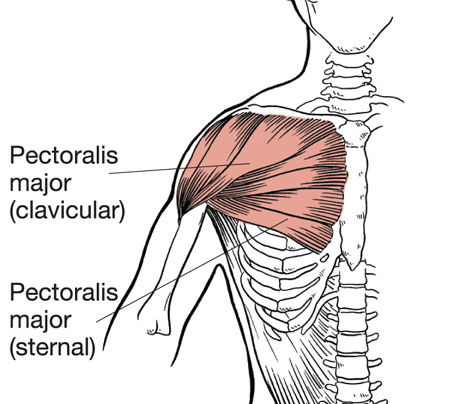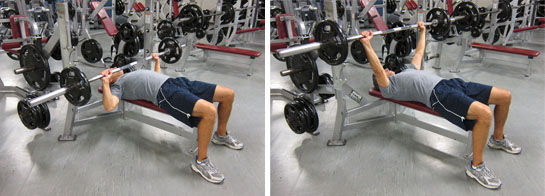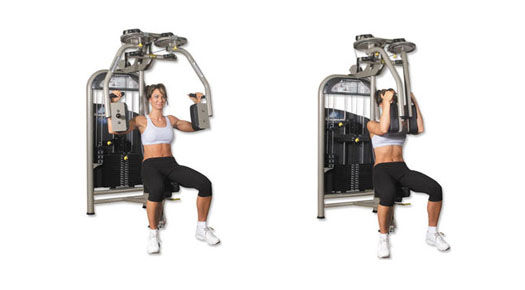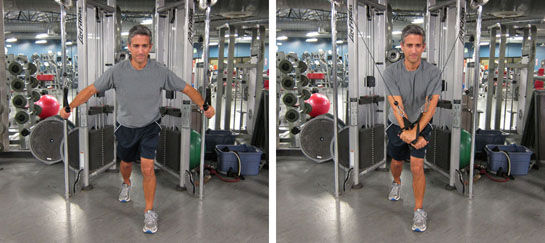
By Whitnee Schanke, M.S., John P. Porcari, Ph.D., Emmanuel Felix, Ph.D., Charles Hendrix, M.S. Ed., and Carl Foster, Ph.D.
New ACE-sponsored study reveals the most effective exercises for strengthening and toning the chest muscles.
Whether you’re swinging a tennis racket, throwing a baseball, or pushing a lawnmower or grocery cart, strong chest muscles are essential to a wide range of everyday activities and sports. Toned pecs are also key for improving your physique (for both men and women), so it’s no surprise that when it comes to strength training, chest exercises are among the most popular.
With this in mind, researchers from the University of Wisconsin, La Crosse, set out to determine which one of the most common strength-training exercises is the most effective way to strengthen and tone the chest.
The Study
ANATOMY OF THE CHEST MUSCLES 
Led by Whitnee Schanke, M.S., and John P. Porcari, Ph.D., a team of researchers from the University’s Department of Exercise and Sport Science recruited 14 healthy male volunteers ages 19 to 30. To ensure proper lifting and exercise technique, all participants had previous experience in resistance training.
Researchers began by choosing nine of the most commonly used exercises for strengthening the chest muscles. Then, to set a baseline of fitness for each subject, on the first day of testing a one-repetition max (1 RM) was determined for five moves: barbell bench press, bent-forward cable crossovers, seated chest press, incline dumbbell flys and pec deck. 1 RM evaluations were not performed for the four exercises that rely solely on bodyweight for resistance: dips, suspended push-ups, stability-ball push-ups and standard push-ups.
After a minimum of three days of rest, subjects returned to the lab for a second day of testing. Electromyography (EMG) electrodes were carefully placed on the pectoralis major muscles of each subject. EMG testing and analysis included motor-unit recruitment, firing rate and synchronization to determine which chest exercise resulted in the highest level of muscle activation.
After a short warm-up, subjects performed five repetitions (with 30 seconds of rest between reps) of each of the nine chest exercises, in random order. For the exercises that did not use body weight, subjects used 80 percent of their predetermined 1RM for the exercise. Following each exercise, subjects were given five minutes of rest for full recovery while researchers recorded the subjects’ ratings of perceived exertion (RPE).
The Results
After crunching the numbers and data, researchers found that out of the nine exercises tested, the pectoralis major was activated the most during the barbell bench press. Therefore, data-wise, all of the other exercises were statistically compared to that exercise and reported as a percentage of that value.
Both the pec deck (at 98% of muscle activation compared to barbell bench press) and the bent-forward cable crossover (93% of muscle activation) elicited nearly equivalent muscle activation as the barbell bench press. Likewise, ratings of perceived exertion for each of the three exercises were comparable as well (Table 1).
|
Table 1. Average EMG and RPE for Each Exercise
Compared to the Barbell Bench Press
|
| Exercise |
Average EMG
|
RPE
|
| Barbell Bench Press |
100 |
6.5 ± 1.98 |
| Pec Deck Machine |
98 ± 26.4 |
5.4 ± 2.13 |
| Bent-Forward Cable Crossovers |
93 ± 22.0 |
5.1 ± 1.60 |
| Chest Press Machine |
79 ± 22.4* |
4.3 ± 2.30* |
| Inclined Dumbbell Flys |
69 ± 30.5* |
5.0 ± 1.50 |
| Dips |
69 ± 15.8* |
2.9 ± 2.06* |
| Suspended Push-ups |
63 ± 18.5* |
3.6 ± 2.22* |
| Stability Ball Push-ups |
61 ± 20.7* |
2.3 ± 1.72* |
| Standard Push-ups |
61 ± 20.6* |
1.5 ± 1.15* |
*Significantly lower than barbell bench press (p < .05)
Values represent the percent (%) muscle activation compared to the barbell bench press.
All of the remaining exercises tested elicited significantly lower muscle activation and RPE values than the barbell bench press. “The exercises that elicited the least amount of activation were actually the push-ups,” says study author Whitnee Schanke, B.S. “They came in at only 61 to 63 percent on average. Granted,” he adds, “we didn’t add any weight to the push-ups.” Although each of the three push-ups tested target the chest muscles, subjects were not ‘lifting’ as much weight percentage-wise, so more reps (nearly twice as many) would be required to equal that of the top three exercises.
The Bottom Line
“Essentially, you can use the barbell bench press, pec deck or the cable crossovers interchangeably,” says John P. Porcari, Ph.D. “All three of those exercises are basically going to give you the same amount of muscle activation in the chest and are equally effective.”
“If people are worried about not having enough time to work out,” says Schanke, “they can actually get the most benefit out of one of the three exercises that we found best works the chest and, thus, get greater gains in less time.”
Sounds good to us.
This study was funded solely by a grant from the American Council on Exercise (ACE).
How to Do the Top Three Moves Correctly

Barbell Bench Press
Start with your feet flat on the ground and your back flat against the bench. The hands should be placed slightly wider than the shoulders, so that when the upper arms are in line with the body, the forearms are perpendicular to the floor, with the elbows flexed at a 90-degree angle. Grasp the bar with a full grip, with the fingers wrapped around it, and lower it with control to touch the chest. Slowly press the barbell upward, fully extending the elbows. Pause and slowly return the weight to the chest and repeat.
TIP: “What many people miss in this motion is the natural arc, which moves the bar from nipple-level to eye-level, when moving from the bottom to top positions,” says Kelly. “In addition, many people descend too fast and let their elbows travel upward too much on the ascent, which can cause shoulder injury. Instead, descend in a slow, controlled manner while keeping the elbows under the wrists at all times.”

Photo courtesy of Johnson Health Tech
Pec Deck*
Place your feet flat on the floor, shoulder-width (or wider) apart, and press your back firmly against the back pad. Elevate and bend your elbows 75 to 90 degrees at shoulder level, and position them directly against the center of the pad on the rotating portions, sometimes called the “wings.” Slowly push the wings all the way toward the center until they are just about to meet. Then slowly reverse the motion back to the starting position.
TIP: “Many users will adopt their own technique on this machine to do more weight, which is a big mistake and can result in injury,” says ACE Exercise Physiologist Mark P. Kelly, Ph.D. “Quite often, the lifter will use too much weight and be unable to complete the full range of motion or will lift the upper back off the back pad to finish the motion.”
* Although the researchers in the study reported a high level of muscle activation during the pec deck exercise, recommending its use with clients should be approached with caution. This exercise places the shoulder in abduction and external rotation, which is a vulnerable position for the joint (especially the anterior structures). Therefore, fitness professionals should avoid using the pec deck exercise with clients who have a history of shoulder dysfunction.

Bent-forward Cable Crossover
Start with your feet hip-width apart in line with the body or with the feet in a staggered stance, a little wider than a walking stride. Grip a handle in each hand. Your hands should be lower than the shoulders and your elbows should be slightly bent. Slowly bring your hands together with the arms almost fully extended. Think about moving the arms downward first and then inward to get a nice wide arc. Slowly return to the starting position and repeat.
TIP: “Avoid moving the torso closer to the hands,” says Kelly. “Also, some exercisers start with the shoulders in horizontal hyperextension or the arms behind the torso, and then actually cross the two handles above and below each other to come past the midline. While this extreme range of motion may feel good, it does little in terms of muscular conditioning, and there is a risk of injury in the shoulder during hyperextension and of the hand when the handles pass so close to each other.”